Q50 HEAD LIGHT SYSTEMS
Q50 Active Adaptive Front Lighting Overview
The Owner’s Manual uses the term Adaptive Front Lighting System (AFS); and the ESM uses the term Active Adaptive Front-Lighting System (AFS). These two different publications are describing the same system. AFS also includes Headlamp Auto Aiming.
AFS automatically adjusts (swivels) the headlamp low beams toward the turning direction to improve the driver’s view as follows:
- A/T shift selector must be in Neutral or any Forward position.
- Swivel control occurs only when the headlights are set to Low Beam.
- Both headlamps swivel ABOVE about 3 mph moving forward.
- Only the right headlamp swivels BELOW about 3 mph moving forward.
- Headlamps do not swivel above 124 mph.

Headlamp Auto Aiming (part of the AFS system) adjusts the height of the headlamps up or down automatically. The number of occupants in the vehicle, the load the vehicle is carrying and road conditions could affect the headlamp aim. The AFS control unit, based on information from the height sensor, calculates the optimal adjustment and adjust the headlamps as needed.
Headlamp aiming motor
The headlamp aiming motor (used in the auto aiming
feature) adjusts the headlamp up or down as needed. This
motor is integrated into the front combination lamp.

Swivel actuator
The swivel actuator is also integral in the front combination
lamp and consists of the following:
- Swivel motor
- Swivel position sensor
- Local control unit (LCU)
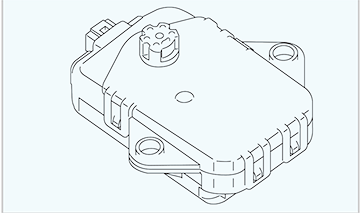
Height sensor The height sensor (mounted on the rear suspension arm) detects the vehicle pitch angle and sends that information to the AFS control unit. Its signal is used to determine the correct adjustment for the headlamp auto aiming.
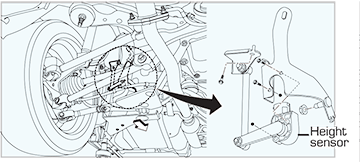
AFS control unit
- Controls the AFS headlamp swivel control and the headlamp aiming control
- Performs the initialization (self-test) at startup
- Sends a request to the combination meter to display AFS warning, when necessary

Q50 AFS Diagram
The AFS control unit
receives inputs directly
from the height sensor
and swivel position
sensor which is built into
the swivel actuator.
The AFS control unit
also recieves inputs on
the CAN for
the following:
- Engine speed
- Low beam
- Shift lever position
- Vehicle speed
- Steering angle
The AFS control unit outputs signals to the Headlamp aiming motors and the LCUs which are built into the Swivel actuators.

Other AFS Operating Conditions
If the AFS has a malfunction or sets a DTC:
- The AFS warning message may illuminate in the vehicle information display.
- The AFS may not operate correctly.
- Depending on the DTC, Swivel control may:
- Stop the left, the right or both swivel motors at the position when DTC is detected.
- Return the left, the right or both swivel motors to straight ahead position and stop.
- Height control may stop right and left headlamp aiming motors at the position when DTC is detected.
AFS System Error See Owner’s Manual
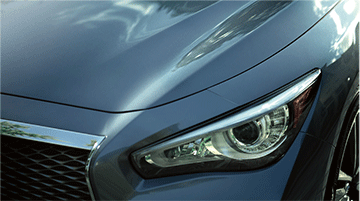
NOTE: During engine startup, AFS initializes the swivel actuators. As part of this initialization, the headlamps are swiveled through their full range of motion and back to center. Customers may describe this movement as a vibration in the headlights. This is a normal characteristic of the AFS.
Q50 DAYTIME RUNNING LIGHTS
The daytime running lights come on automatically under the following conditions:
- Engine is running
- Parking brake is released
- Headlamp switch is OFF
- Headlamp switch is set to Auto, but ambient light is bright enough for headlamps to be OFF.
- System Diagram
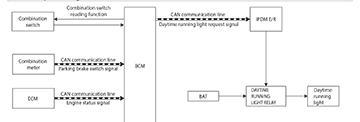
Q50 FOG LIGHT OVERRIDE
Several Nissan and Infiniti vehicles
are equipped with the fog light
override function. When the front
fog light switch is turned ON with
the headlight switch set to AUTO,
the BCM turns ON all exterior lights,
including the headlights, regardless
of outside brightness, overriding the
Auto light function.
The reasoning for this override is;
if you need fog lights, then you also
need headlights. Turning the fog
lights ON overrides the Auto light
function even during the daytime.
The fog light override function can be
turned OFF or ON with C-III plus.
BCM > INT lamp > Fog Lamp Override
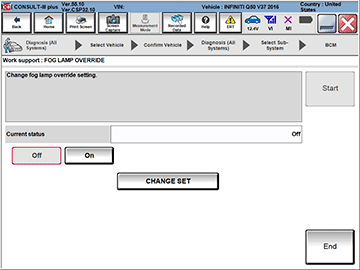
Q50 HIGH BEAM ASSIST FUNCTION
The high beam assist system automatically switches the headlights to low beam and then back to high beam while driving at night. If the system detects an oncoming vehicle or a vehicle ahead in the same lane, at night, while driving with the high beams ON, it switches the headlights to low beam. When no oncoming vehicles or no vehicles ahead in the same lane are detected, then the system switches the headlights back to high beam.
High beam assist functions under the following conditions:
- Headlight switch set to Auto and High beam
- Vehicle speed below approximately 17 mph, high beam assist selects low beam only.
- Vehicle speed above approximately 22 mph, high beam assist automatically sets low or high beam as described.
NOTE: If the headlamp switch is set to manual ON, high beam assist does not operate.
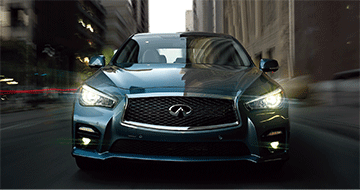
Q50 HIGH BEAM ASSIST COMPONENTS
High beam assist system main components are:
- High beam assist control module
- Determines low beam or high beam
- Image sensor
- Detects the color and brightness of the light in front of the vehicle
- Ambient light sensor
- Detects ambient light in the area
- Optical sensor
- Also detects ambient light
- BCM
- IPDM E/R
- High beam assist indicator light
The high beam assist control module, the image sensor, and
the ambient light sensor are all integrated into the inside
rearview mirror.
The optical sensor is located on the top right area of the
instrument panel. The optical sensor converts the outside
brightness (lux) to voltage and transmits the optical sensor
signal to the BCM.

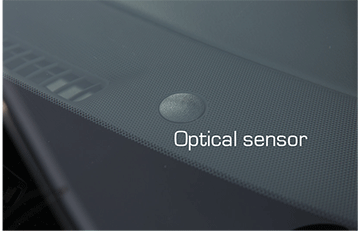
The high beam assist indicator light illuminates in the combination meter when:
- The headlamp switch is set to Auto and high beam, and
- Ambient light is low enough for auto lights to turn on.
This indicator light stays illuminated as long as the high beam assist is in operation.
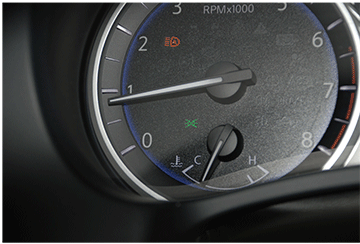
The high beam indicator light will illuminate the same with
either high beam assist or manual beam operation.
Low beam – indicator is OFF
High beam – indicator is ON
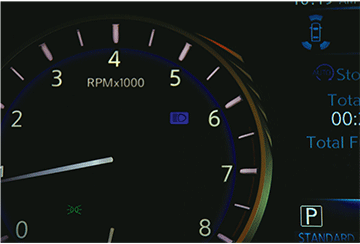
Q50 High Beam Assist System Diagram
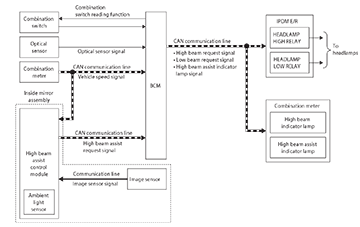
Q50 HIGH BEAM ASSIST FAIL-SAFE
Whenever a DTC for the
high beam assist system
or CAN line sets, the
high beam assist stops
operating and the high
beam assist indicator
lamp stays OFF.
The automatic switching
from high beam to low
beam will not occur when
a DTC is stored. However,
the high beams still work
when the headlights
are ON or in the AUTO
position, and the high
beams are manually
switched ON.
Q50 AUTO LIGHT WITH TWILIGHT FUNCTION
The auto light system in some Nissan and Infiniti vehicles
is equipped with a twilight function.
“Twilight on” can be turned OFF (MODE 1) or ON (MODE
2) using C-III plus under BCM > Headlamps > Work
support.
MODE 1:
Standard mode. The twilight function is turned OFF
(disabled).
MODE 2:
The vehicle comes from the factory set to MODE 2,
which enables the twilight function. With twilight function
enabled (ON) and the headlight switch set to Auto, the
headlights will be ON with a greater amount of ambient
light than in MODE 1.
In other words, in MODE 2:
- In the evening as the sun is going down the headlights will come on sooner/earlier.
- In the morning as the sun is coming up, the headlights will stay on longer/later.
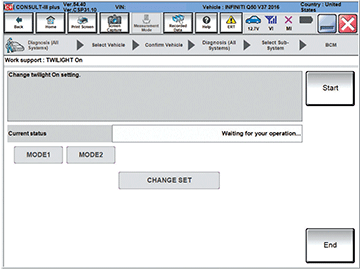
NOTE: The sensitivity selections under Settings for the auto light still function the same, but the sensitivity of each selection is shifted to earlier in the evening and later in the morning as described for MODE 2.